by Jason Bodner
September 6, 2023
Labor Day finally arrived. That’s the unofficial end of summer. It’s also the unofficial end of hot dog season. According to the National Hot Dog and Sausage Council, Americans will eat seven billion hot dogs between Memorial Day and Labor Day. That’s a lot of hot dogs, over 20 dogs per person.
That’s enough to make you sick. As if August’s volatility wasn’t enough to make you sick…
Well, according to history, September doesn’t offer much hope for a reprieve. August has delivered a -0.61% return for the S&P 500 (since 1990), but September is worse at -0.80%. Time for more Tums:
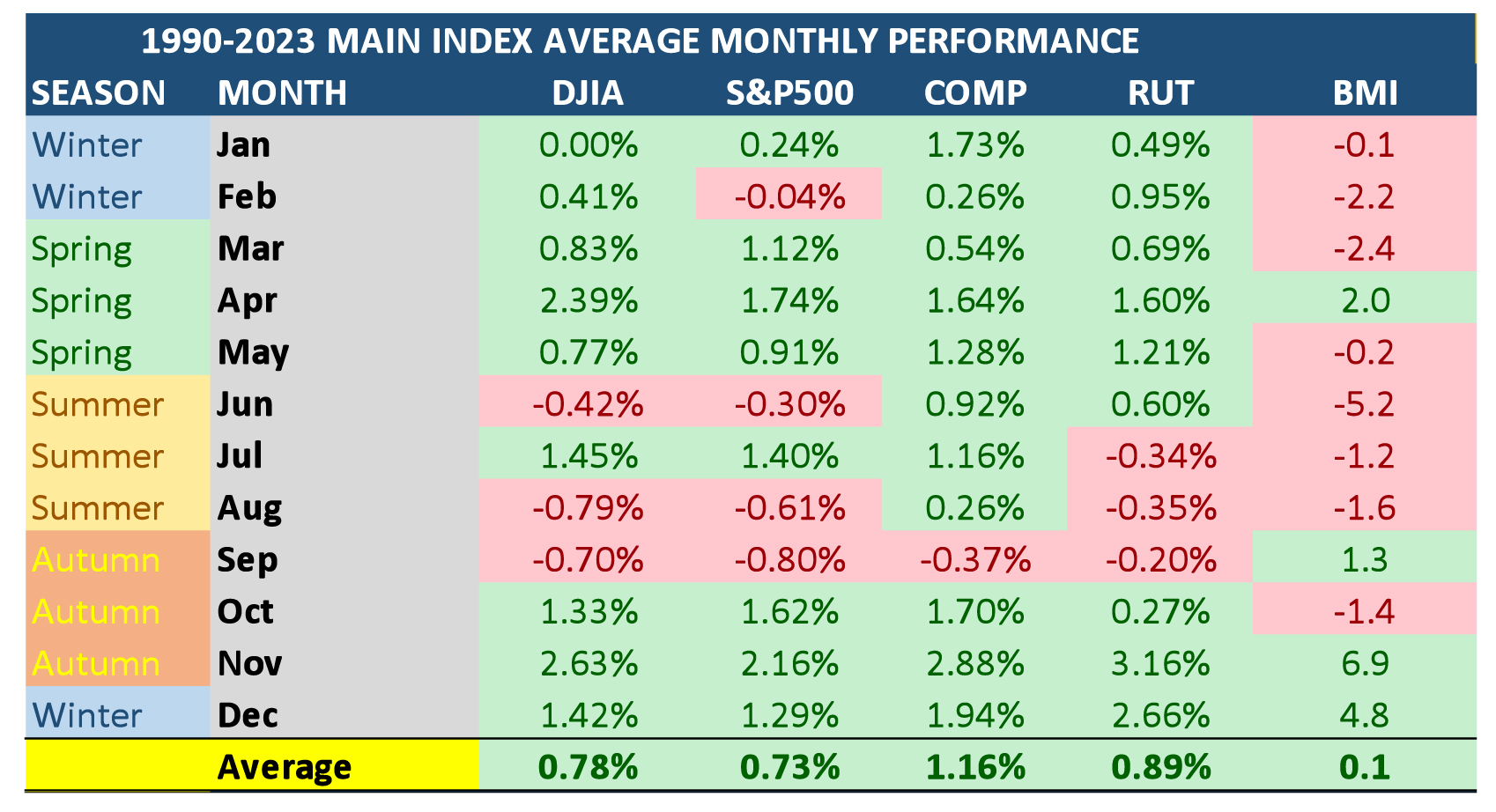
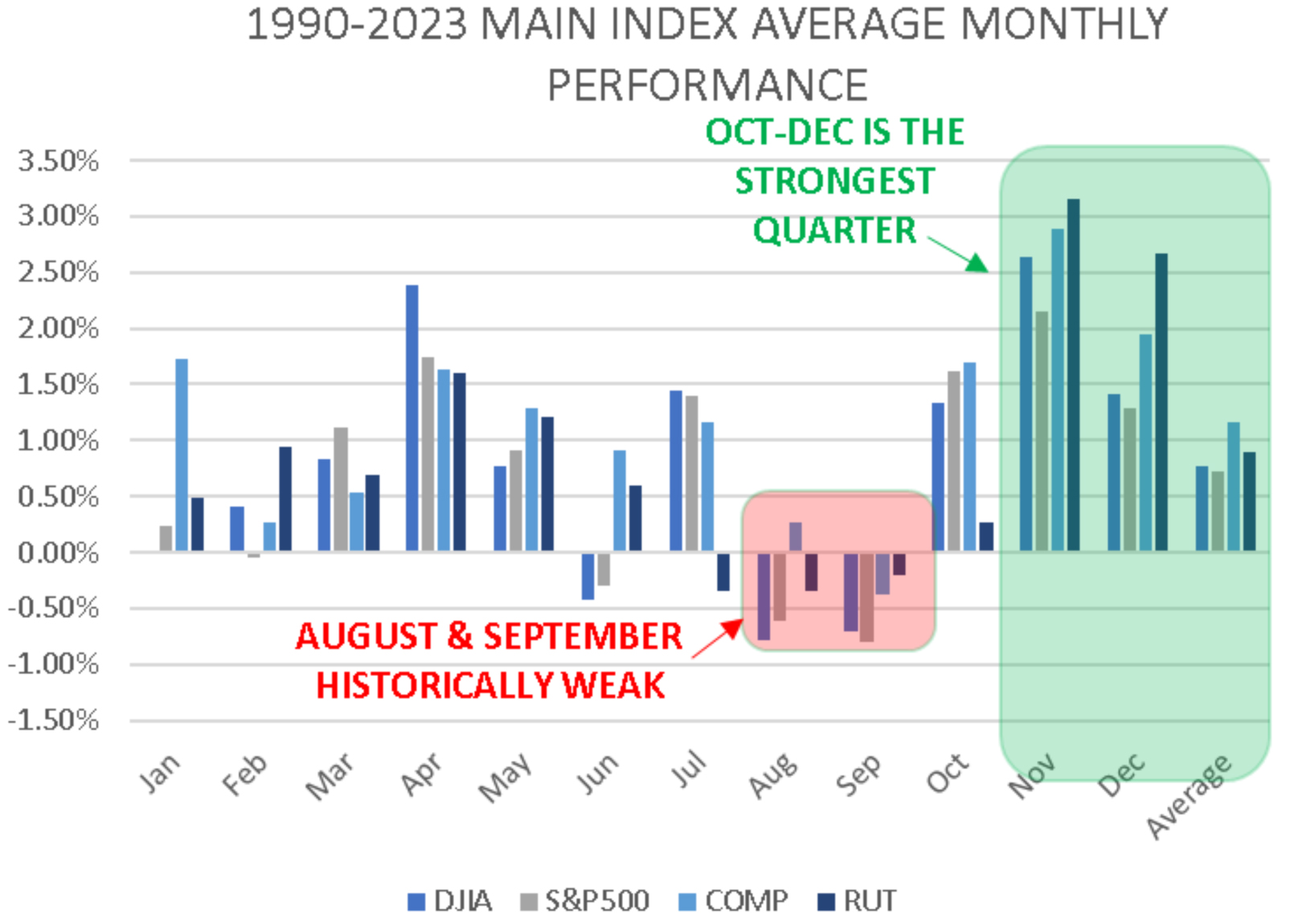
Graphs are for illustrative and discussion purposes only. Please read important disclosures at the end of this commentary.
The good news, of course, is that markets tend to rally handsomely in the fourth quarter. The average return since 1990 for October through December is a stunning +5.08% for the S&P 500. While the first three weeks of August were unsettling, the last week was quite pleasant, with a big lift in equity prices.
The questions loom: Are we out of the woods, or is this a head fake, and are we in for more discomfort?
I’ll attempt to answer that question with a dive into the data. Since August 24th, SPY has rallied by a lovely +3.4%. This sounds great until we factor in the first part of the month, which saw the index ETF trough at -4.6%. The SPY finished August -1.5%, so we can wonder if the buying at month’s end was short covering or buying of some significance. The answer is that I notice some positive data that could continue, but like all things in life, nothing is guaranteed, and we also see some warning signs.
First, let’s check in on the Big Money Index (BMI). As predicted, it started falling from overbought, and plummeted through August, falling from 83.9% to 51.5%. If selling were to have continued, the BMI would have kept falling right into oversold territory – which is a bullish indicator. But instead, the recent lack of selling, mixed with the beginning signs of buying, has slowed the BMI’s descent considerably.
We can see the line bending from a sharp decline to a flattening:
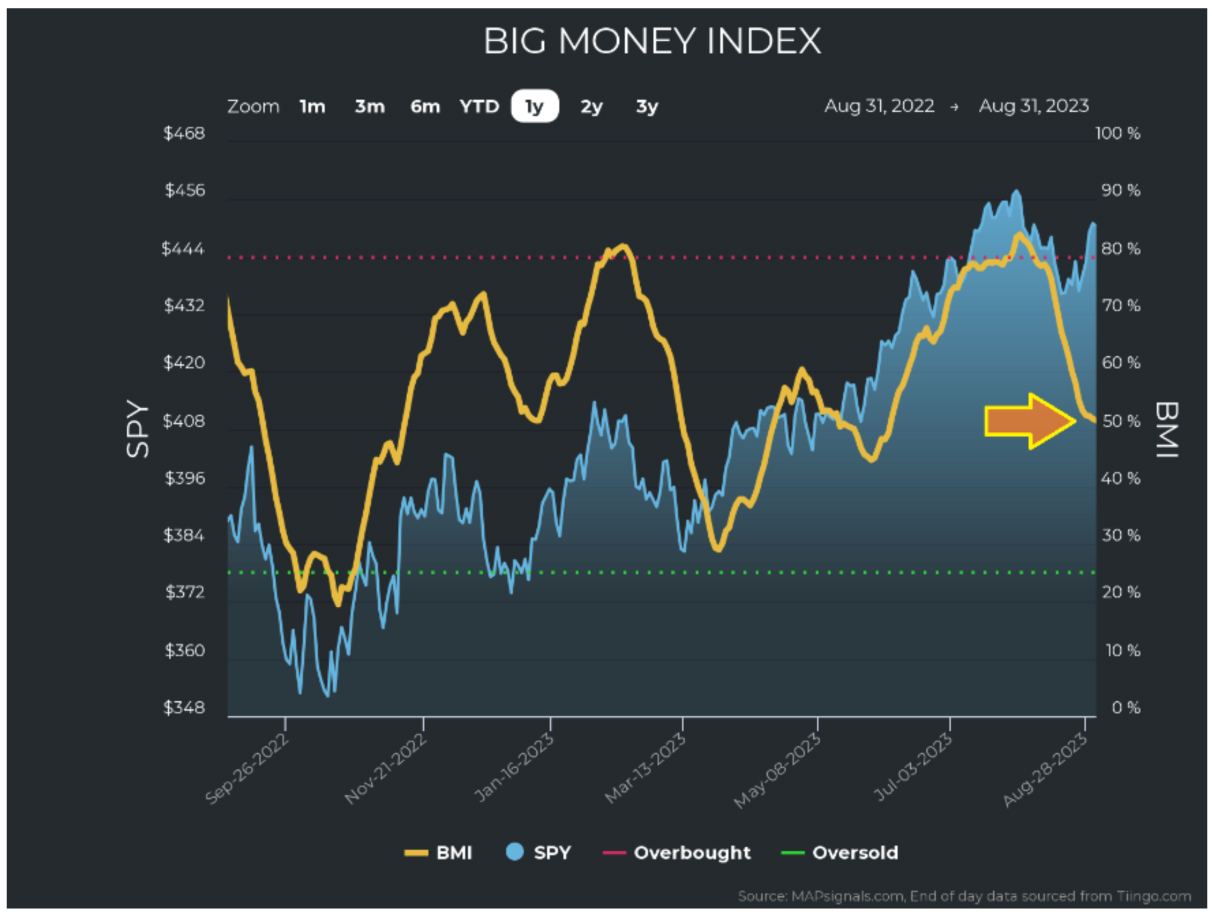
Graphs are for illustrative and discussion purposes only. Please read important disclosures at the end of this commentary.
To contextualize this rebound, let’s look into the individual days of buying and selling. We see below that selling in stocks and ETFs suddenly stopped. Stock selling gave way to some healthy signs of buying:
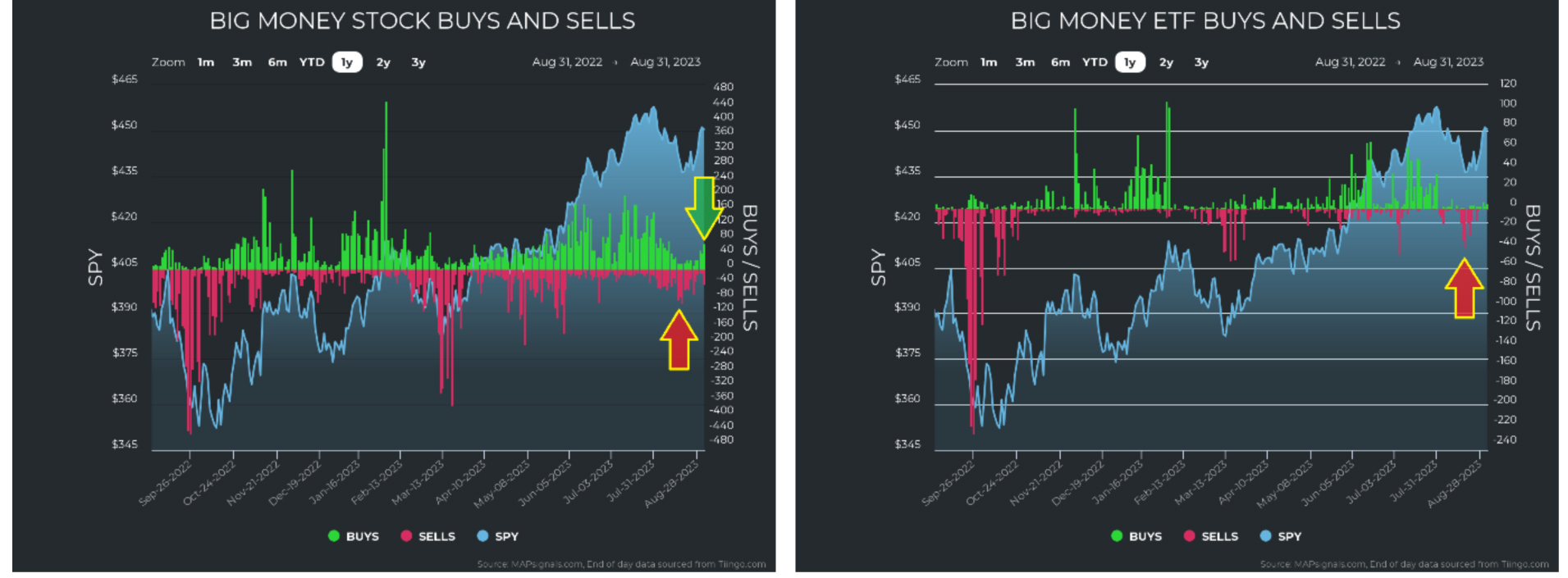
Graphs are for illustrative and discussion purposes only. Please read important disclosures at the end of this commentary.
This is a positive sign. That’s because if this were purely short covering, we wouldn’t necessarily see buy signals. It’s important to note that a buy signal has a breakout time component. This means that in order to make a green signal, one of the criteria is to break through a roughly 11-week high on big volume, so simply selling shares and covering lower, wouldn’t result in green buy signals. Buying shares to new their three-month highs, would. And that’s what we are starting to see.
Another interesting point is that in the last weeks of August, volumes are usually thin. As most of Wall Street is usually on vacation, it’s tumbleweed time. But not last week. If we look at a chart of unusual trading, we see amber bars denoting the cumulative number of unusually high-volume trades, according to MAPsignals data. We clearly see that last week’s rally was accompanied with a visible spike in unusual trading volume, while much of the prior ugly market action was coupled with lower volumes:
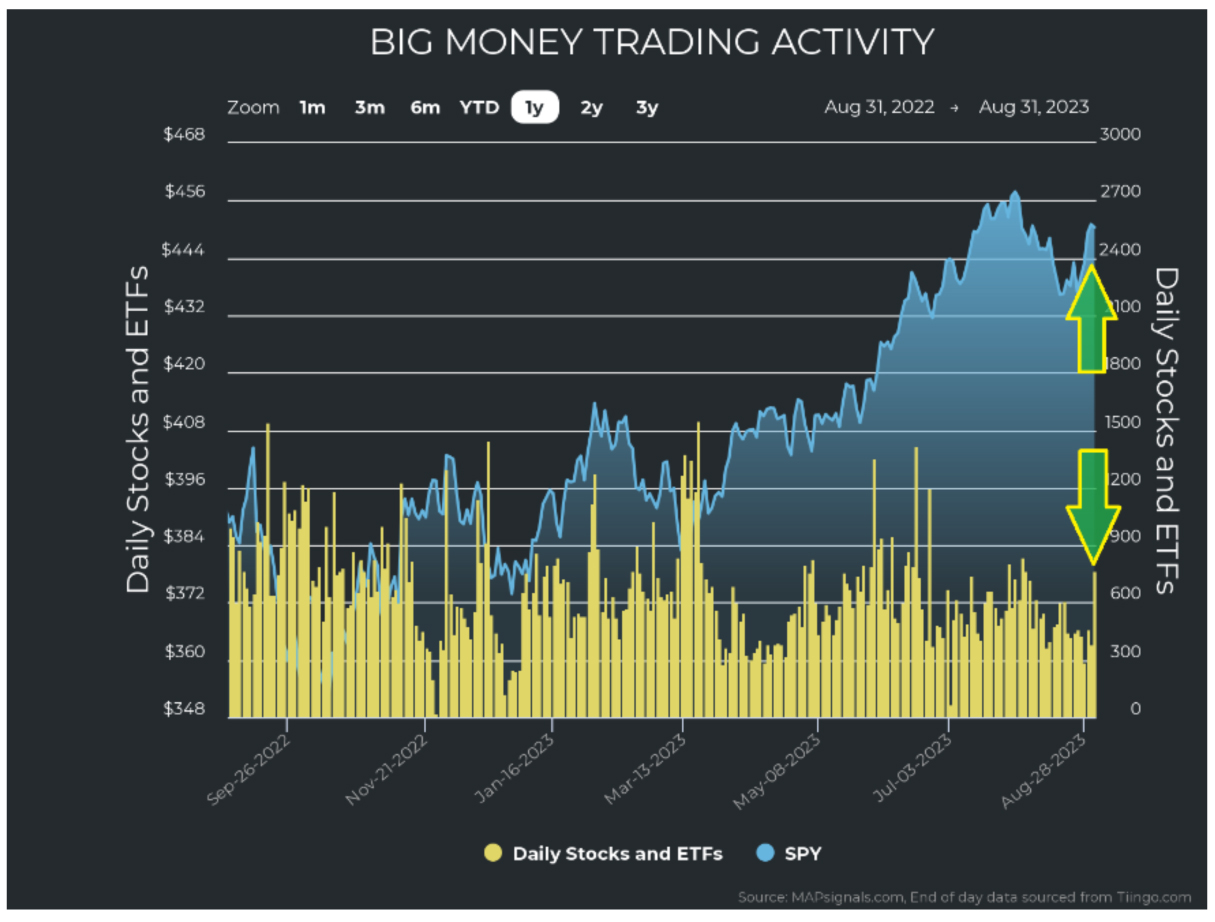
Graphs are for illustrative and discussion purposes only. Please read important disclosures at the end of this commentary.
That’s a healthy early sign of a new bullish trend. Perhaps it’s too early, but it’s healthy all the same. It’s also good to look at what sectors investors bought. We see that small- and mid-cap stocks were in favor when it came to buying. This is also a healthy sign, as growth usually litters these lower market-cap tiers:
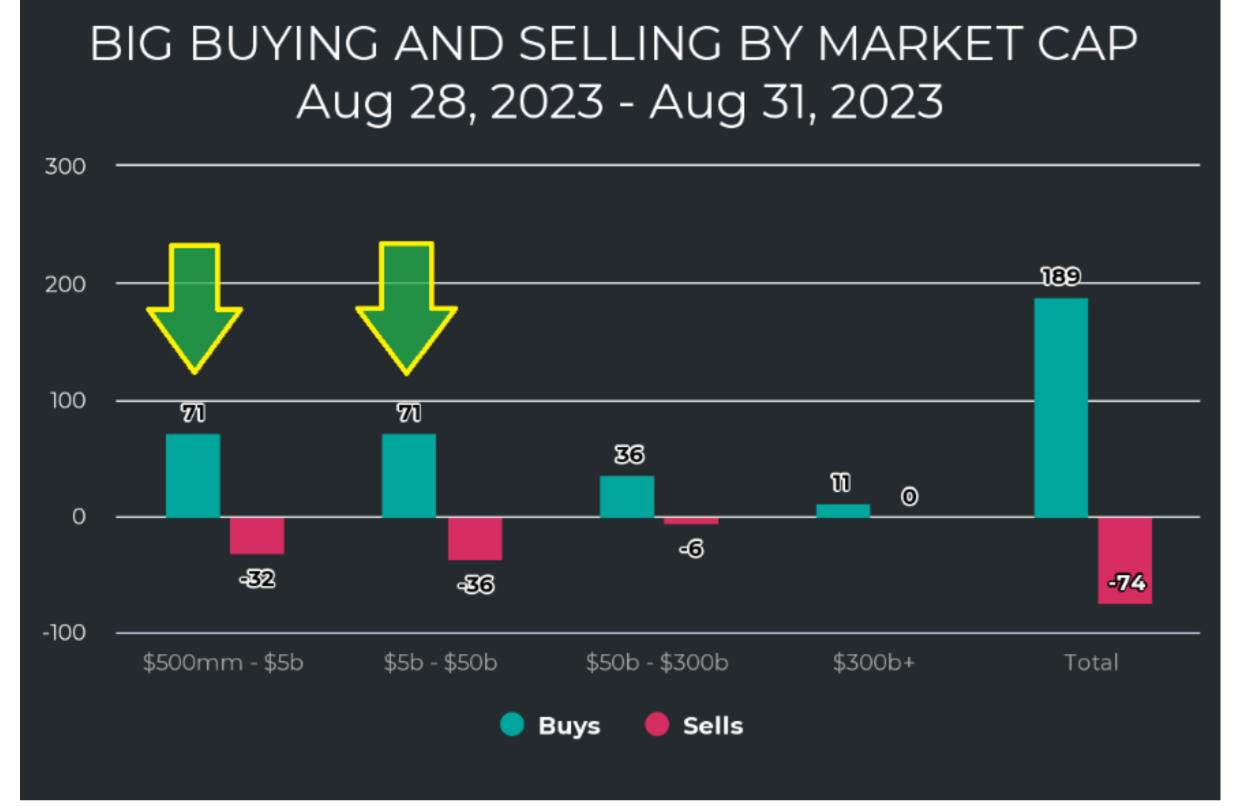
Graphs are for illustrative and discussion purposes only. Please read important disclosures at the end of this commentary.
When we look to sector leadership, a few things jump out at me. First, technology regained its top leadership position after much of August, falling further down the list, and a look at the top 4 sectors reveal that growth is still leading. Tech, energy, discretionary, and industrials are the top 4 sectors:
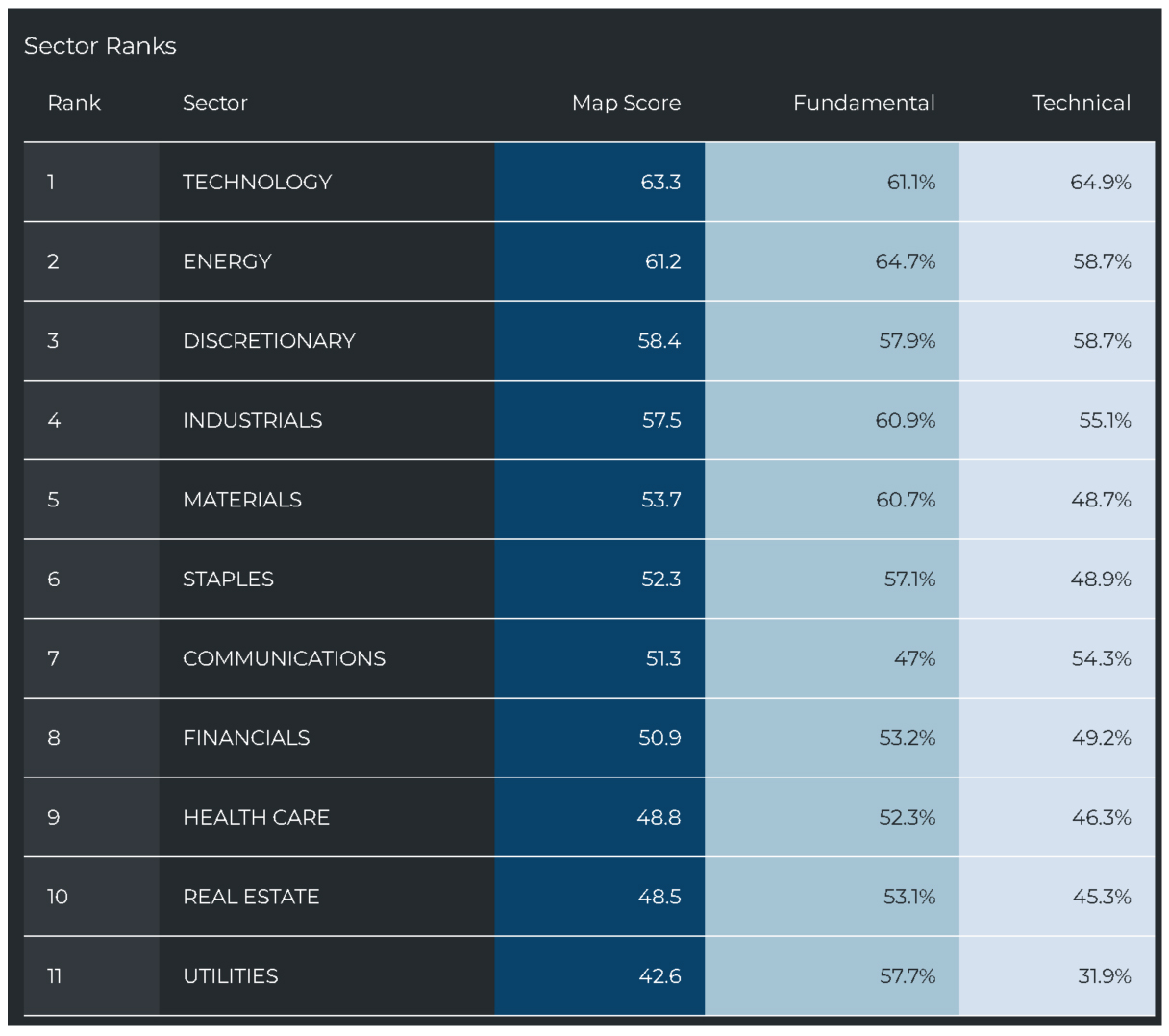
Graphs are for illustrative and discussion purposes only. Please read important disclosures at the end of this commentary.
Things continue to get interesting when we look at the sector charts in order of their ranking. I am making #1 larger because it reveals something encouraging: Tech saw a huge single day bonanza of buying:
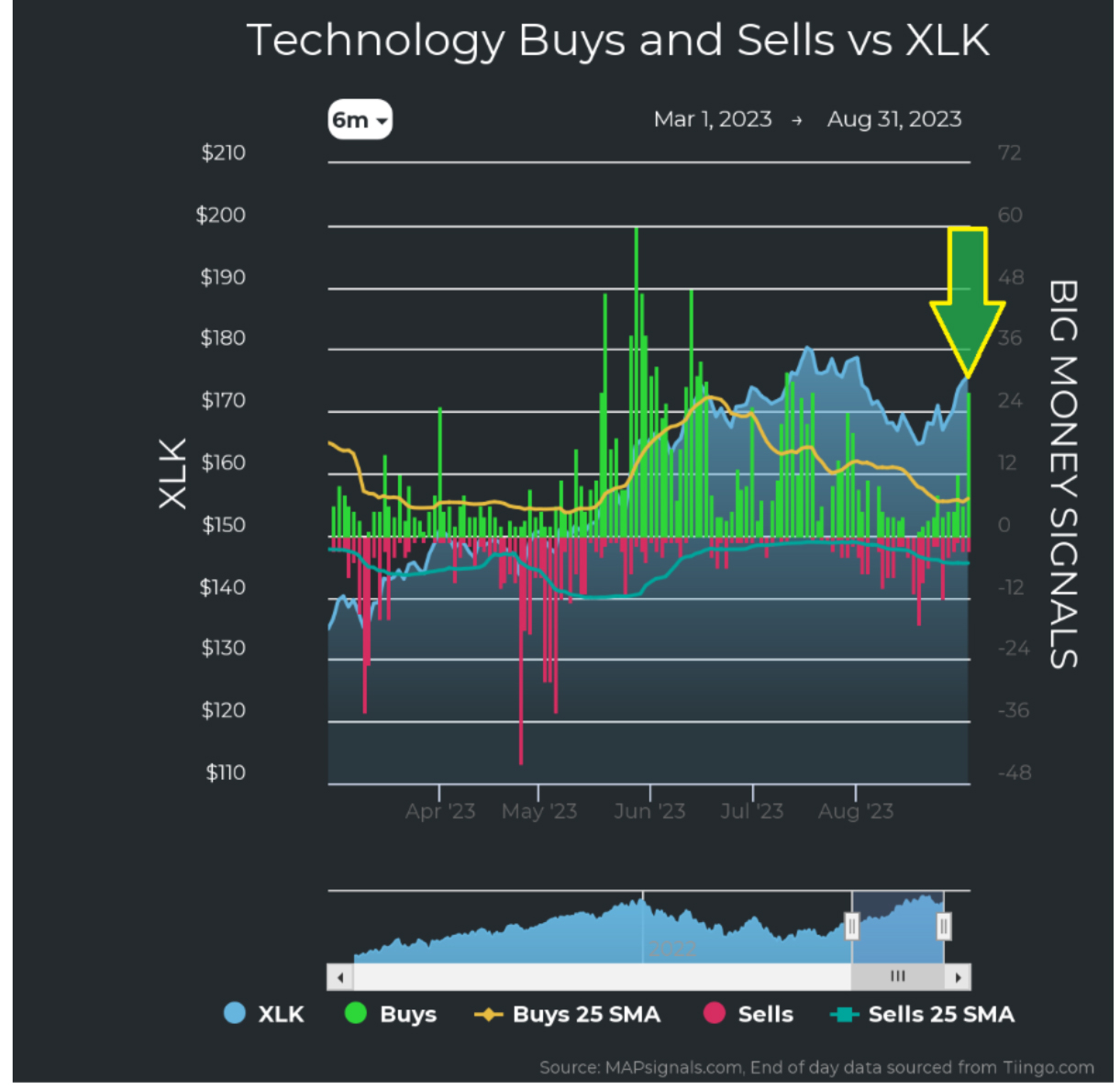
Graphs are for illustrative and discussion purposes only. Please read important disclosures at the end of this commentary.
That’s the most buying of tech stocks we’ve seen since the sector index peaked in July. And in looking at which tech stocks saw buying, it’s a solid mix of large cap and small cap technology companies. Semiconductors, chip-makers, and software stocks got scooped up on the last day of the month.
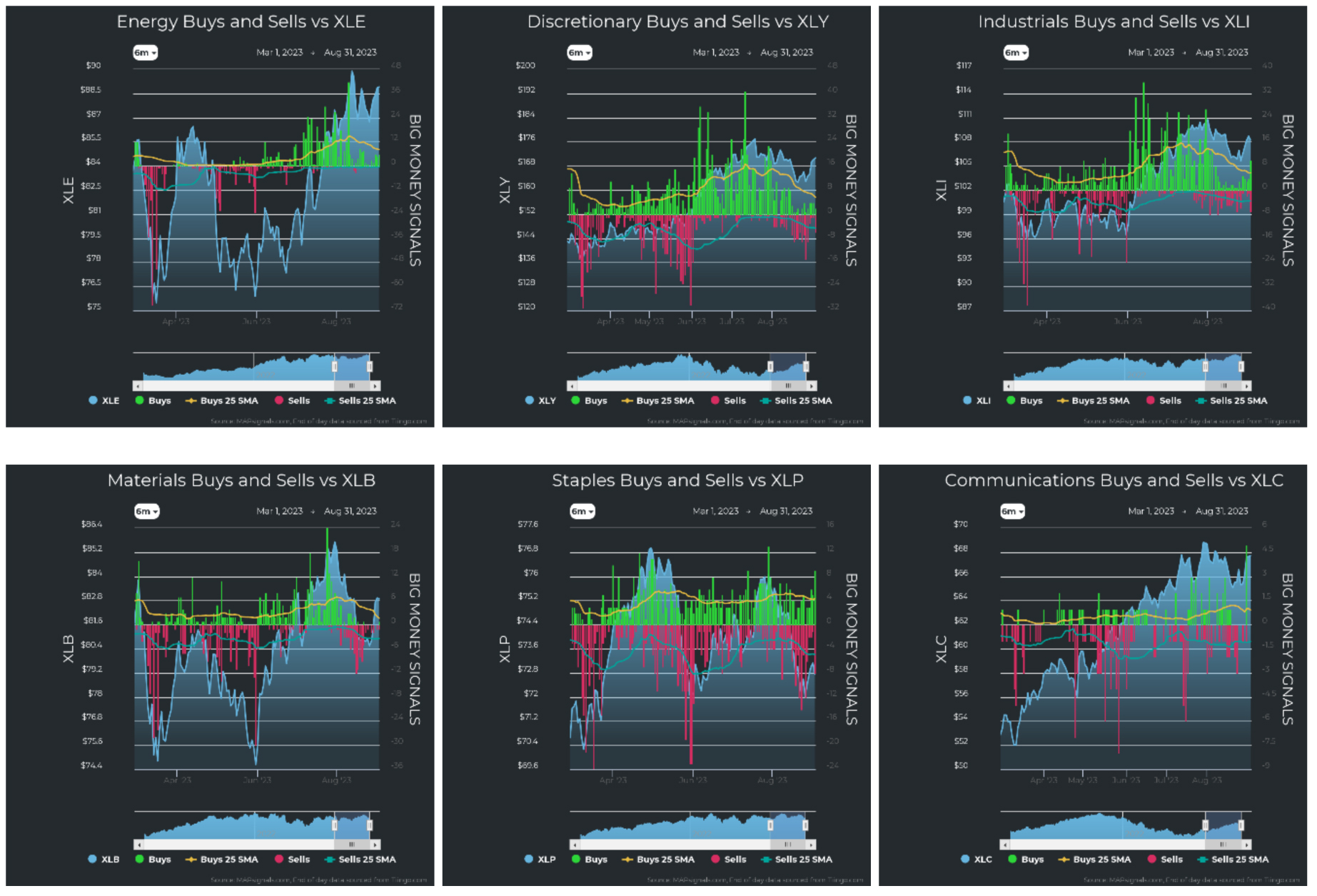
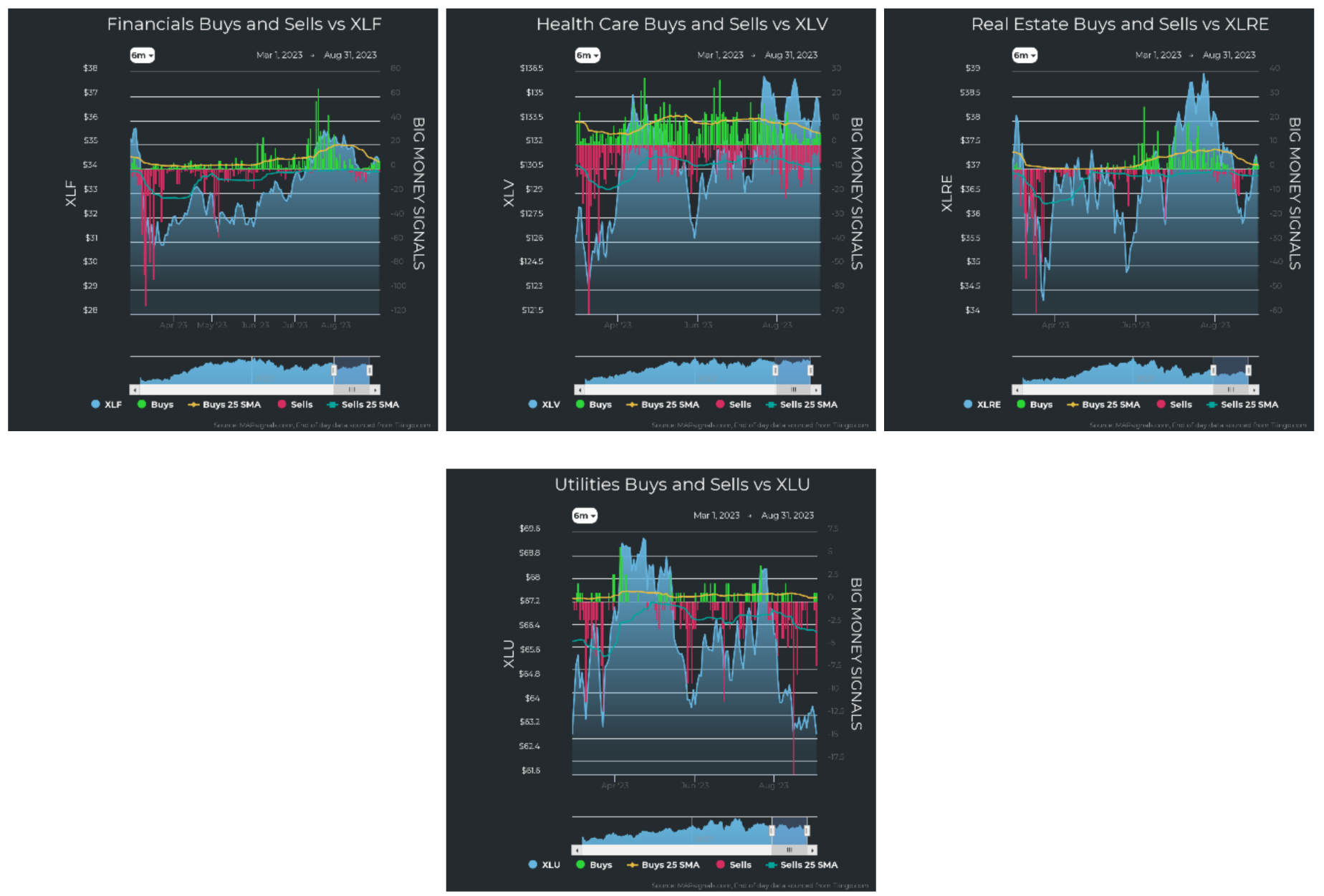
Graphs are for illustrative and discussion purposes only. Please read important disclosures at the end of this commentary.
There are signs that this market could rise. But then again, the BMI is a 25-day moving average of all buying and selling. When we download the individual days’ worth of data, we see that strong buy-days are rolling off the data set. And what’s left is stronger selling-days that will outnumber the weaker buys and the 25-day roll-off marches on. This means, in absence of significant buying, the BMI may continue to fall. That fits the narrative for a historically volatile summer, when volume returns to the market.
We don’t know if the recent rally prefaces more. On the one hand, buying was constructive, lifting tech stocks to sector #1. Growth was accumulated in smaller and mid-sized market caps. On the other hand, the BMI needs support of strong buy-days to replace those rolling off the 25-dma. Fresh buys could start to lift the BMI, but if we start September with selling, the BMI could resume its fall.
Either way, we have the fourth-quarter lift to look forward to.
In the meantime, if you’re a hotdog eater, I hope you enjoyed the unofficial last hot dog days of summer.
Henry Rollins nicely sums up where we are now: “We know that in September, we will wander through the warm winds of summer’s wreckage. We will welcome summer’s ghost.”
All content above represents the opinion of Jason Bodner of Navellier & Associates, Inc.
Also In This Issue
A Look Ahead by Louis Navellier
Conflicting Jobs Data Begin to Clear Up Over Labor Day
Income Mail by Bryan Perry
Is It Time to Consider Buying Long-Dated Bonds?
Growth Mail by Gary Alexander
Labor Day Report: When is a Job Not a Job?
Global Mail by Ivan Martchev
Wild Cards for September
Sector Spotlight by Jason Bodner
The Hot Dog Days of Summer Are Finally Over
View Full Archive
Read Past Issues Here

Jason Bodner
MARKETMAIL EDITOR FOR SECTOR SPOTLIGHT
Jason Bodner writes Sector Spotlight in the weekly Marketmail publication and has authored several white papers for the company. He is also Co-Founder of Macro Analytics for Professionals which produces proprietary equity accumulation/distribution research for its clients. Previously, Mr. Bodner served as Director of European Equity Derivatives for Cantor Fitzgerald Europe in London, then moved to the role of Head of Equity Derivatives North America for the same company in New York. He also served as S.V.P. Equity Derivatives for Jefferies, LLC. He received a B.S. in business administration in 1996, with honors, from Skidmore College as a member of the Periclean Honors Society. All content of “Sector Spotlight” represents the opinion of Jason Bodner
Important Disclosures:
Jason Bodner is a co-founder and co-owner of Mapsignals. Mr. Bodner is an independent contractor who is occasionally hired by Navellier & Associates to write an article and or provide opinions for possible use in articles that appear in Navellier & Associates weekly Market Mail. Mr. Bodner is not employed or affiliated with Louis Navellier, Navellier & Associates, Inc., or any other Navellier owned entity. The opinions and statements made here are those of Mr. Bodner and not necessarily those of any other persons or entities. This is not an endorsement, or solicitation or testimonial or investment advice regarding the BMI Index or any statements or recommendations or analysis in the article or the BMI Index or Mapsignals or its products or strategies.
Although information in these reports has been obtained from and is based upon sources that Navellier believes to be reliable, Navellier does not guarantee its accuracy and it may be incomplete or condensed. All opinions and estimates constitute Navellier’s judgment as of the date the report was created and are subject to change without notice. These reports are for informational purposes only and are not a solicitation for the purchase or sale of a security. Any decision to purchase securities mentioned in these reports must take into account existing public information on such securities or any registered prospectus.To the extent permitted by law, neither Navellier & Associates, Inc., nor any of its affiliates, agents, or service providers assumes any liability or responsibility nor owes any duty of care for any consequences of any person acting or refraining to act in reliance on the information contained in this communication or for any decision based on it.
Past performance is no indication of future results. Investment in securities involves significant risk and has the potential for partial or complete loss of funds invested. It should not be assumed that any securities recommendations made by Navellier. in the future will be profitable or equal the performance of securities made in this report. Dividend payments are not guaranteed. The amount of a dividend payment, if any, can vary over time and issuers may reduce dividends paid on securities in the event of a recession or adverse event affecting a specific industry or issuer.
None of the stock information, data, and company information presented herein constitutes a recommendation by Navellier or a solicitation to buy or sell any securities. Any specific securities identified and described do not represent all of the securities purchased, sold, or recommended for advisory clients. The holdings identified do not represent all of the securities purchased, sold, or recommended for advisory clients and the reader should not assume that investments in the securities identified and discussed were or will be profitable.
Information presented is general information that does not take into account your individual circumstances, financial situation, or needs, nor does it present a personalized recommendation to you. Individual stocks presented may not be suitable for every investor. Investment in securities involves significant risk and has the potential for partial or complete loss of funds invested. Investment in fixed income securities has the potential for the investment return and principal value of an investment to fluctuate so that an investor’s holdings, when redeemed, may be worth less than their original cost.
One cannot invest directly in an index. Index is unmanaged and index performance does not reflect deduction of fees, expenses, or taxes. Presentation of Index data does not reflect a belief by Navellier that any stock index constitutes an investment alternative to any Navellier equity strategy or is necessarily comparable to such strategies. Among the most important differences between the Indices and Navellier strategies are that the Navellier equity strategies may (1) incur material management fees, (2) concentrate its investments in relatively few stocks, industries, or sectors, (3) have significantly greater trading activity and related costs, and (4) be significantly more or less volatile than the Indices.
ETF Risk: We may invest in exchange traded funds (“ETFs”) and some of our investment strategies are generally fully invested in ETFs. Like traditional mutual funds, ETFs charge asset-based fees, but they generally do not charge initial sales charges or redemption fees and investors typically pay only customary brokerage fees to buy and sell ETF shares. The fees and costs charged by ETFs held in client accounts will not be deducted from the compensation the client pays Navellier. ETF prices can fluctuate up or down, and a client account could lose money investing in an ETF if the prices of the securities owned by the ETF go down. ETFs are subject to additional risks:
- ETF shares may trade above or below their net asset value;
- An active trading market for an ETF’s shares may not develop or be maintained;
- The value of an ETF may be more volatile than the underlying portfolio of securities the ETF is designed to track;
- The cost of owning shares of the ETF may exceed those a client would incur by directly investing in the underlying securities; and
- Trading of an ETF’s shares may be halted if the listing exchange’s officials deem it appropriate, the shares are delisted from the exchange, or the activation of market-wide “circuit breakers” (which are tied to large decreases in stock prices) halts stock trading generally.
Grader Disclosures: Investment in equity strategies involves substantial risk and has the potential for partial or complete loss of funds invested. The sample portfolio and any accompanying charts are for informational purposes only and are not to be construed as a solicitation to buy or sell any financial instrument and should not be relied upon as the sole factor in an investment making decision. As a matter of normal and important disclosures to you, as a potential investor, please consider the following: The performance presented is not based on any actual securities trading, portfolio, or accounts, and the reported performance of the A, B, C, D, and F portfolios (collectively the “model portfolios”) should be considered mere “paper” or pro forma performance results based on Navellier’s research.
Investors evaluating any of Navellier & Associates, Inc.’s, (or its affiliates’) Investment Products must not use any information presented here, including the performance figures of the model portfolios, in their evaluation of any Navellier Investment Products. Navellier Investment Products include the firm’s mutual funds and managed accounts. The model portfolios, charts, and other information presented do not represent actual funded trades and are not actual funded portfolios. There are material differences between Navellier Investment Products’ portfolios and the model portfolios, research, and performance figures presented here. The model portfolios and the research results (1) may contain stocks or ETFs that are illiquid and difficult to trade; (2) may contain stock or ETF holdings materially different from actual funded Navellier Investment Product portfolios; (3) include the reinvestment of all dividends and other earnings, estimated trading costs, commissions, or management fees; and, (4) may not reflect prices obtained in an actual funded Navellier Investment Product portfolio. For these and other reasons, the reported performances of model portfolios do not reflect the performance results of Navellier’s actually funded and traded Investment Products. In most cases, Navellier’s Investment Products have materially lower performance results than the performances of the model portfolios presented.
This report contains statements that are, or may be considered to be, forward-looking statements. All statements that are not historical facts, including statements about our beliefs or expectations, are “forward-looking statements” within the meaning of The U.S. Private Securities Litigation Reform Act of 1995. These statements may be identified by such forward-looking terminology as “expect,” “estimate,” “plan,” “intend,” “believe,” “anticipate,” “may,” “will,” “should,” “could,” “continue,” “project,” or similar statements or variations of such terms. Our forward-looking statements are based on a series of expectations, assumptions, and projections, are not guarantees of future results or performance, and involve substantial risks and uncertainty as described in Form ADV Part 2A of our filing with the Securities and Exchange Commission (SEC), which is available at www.adviserinfo.sec.gov or by requesting a copy by emailing info@navellier.com. All of our forward-looking statements are as of the date of this report only. We can give no assurance that such expectations or forward-looking statements will prove to be correct. Actual results may differ materially. You are urged to carefully consider all such factors.
FEDERAL TAX ADVICE DISCLAIMER: As required by U.S. Treasury Regulations, you are informed that, to the extent this presentation includes any federal tax advice, the presentation is not written by Navellier to be used, and cannot be used, for the purpose of avoiding federal tax penalties. Navellier does not advise on any income tax requirements or issues. Use of any information presented by Navellier is for general information only and does not represent tax advice either express or implied. You are encouraged to seek professional tax advice for income tax questions and assistance.
IMPORTANT NEWSLETTER DISCLOSURE:The hypothetical performance results for investment newsletters that are authored or edited by Louis Navellier, including Louis Navellier’s Growth Investor, Louis Navellier’s Breakthrough Stocks, Louis Navellier’s Accelerated Profits, and Louis Navellier’s Platinum Club, are not based on any actual securities trading, portfolio, or accounts, and the newsletters’ reported hypothetical performances should be considered mere “paper” or proforma hypothetical performance results and are not actual performance of real world trades. Navellier & Associates, Inc. does not have any relation to or affiliation with the owner of these newsletters. There are material differences between Navellier Investment Products’ portfolios and the InvestorPlace Media, LLC newsletter portfolios authored by Louis Navellier. The InvestorPlace Media, LLC newsletters contain hypothetical performance that do not include transaction costs, advisory fees, or other fees a client might incur if actual investments and trades were being made by an investor. As a result, newsletter performance should not be used to evaluate Navellier Investment services which are separate and different from the newsletters. The owner of the newsletters is InvestorPlace Media, LLC and any questions concerning the newsletters, including any newsletter advertising or hypothetical Newsletter performance claims, (which are calculated solely by Investor Place Media and not Navellier) should be referred to InvestorPlace Media, LLC at (800) 718-8289.
Please note that Navellier & Associates and the Navellier Private Client Group are managed completely independent of the newsletters owned and published by InvestorPlace Media, LLC and written and edited by Louis Navellier, and investment performance of the newsletters should in no way be considered indicative of potential future investment performance for any Navellier & Associates separately managed account portfolio. Potential investors should consult with their financial advisor before investing in any Navellier Investment Product.
Navellier claims compliance with Global Investment Performance Standards (GIPS). To receive a complete list and descriptions of Navellier’s composites and/or a presentation that adheres to the GIPS standards, please contact Navellier or click here. It should not be assumed that any securities recommendations made by Navellier & Associates, Inc. in the future will be profitable or equal the performance of securities made in this report.
FactSet Disclosure: Navellier does not independently calculate the statistical information included in the attached report. The calculation and the information are provided by FactSet, a company not related to Navellier. Although information contained in the report has been obtained from FactSet and is based on sources Navellier believes to be reliable, Navellier does not guarantee its accuracy, and it may be incomplete or condensed. The report and the related FactSet sourced information are provided on an “as is” basis. The user assumes the entire risk of any use made of this information. Investors should consider the report as only a single factor in making their investment decision. The report is for informational purposes only and is not intended as an offer or solicitation for the purchase or sale of a security. FactSet sourced information is the exclusive property of FactSet. Without prior written permission of FactSet, this information may not be reproduced, disseminated or used to create any financial products. All indices are unmanaged and performance of the indices include reinvestment of dividends and interest income, unless otherwise noted, are not illustrative of any particular investment and an investment cannot be made in any index. Past performance is no guarantee of future results.
